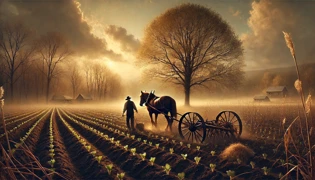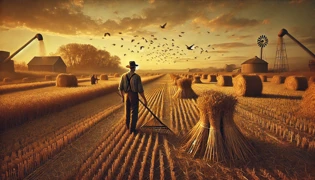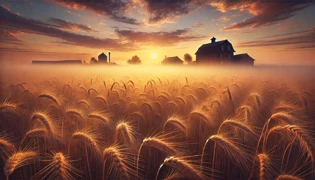Introduction
John Harper never imagined he’d stand on his own land. Raised in a cramped shanty on the outskirts of a fading mill town, he spent childhood watching other men wielding plows in fields he only dared approach. Every morning before dawn he shouldered a worn satchel and trudged across dew-laced meadows to work as hired help on distant farms. The scent of damp earth at sunrise became the closest thing to freedom he’d known, yet he clung to a single ambition: to break ground on a parcel of his own. For years he listened to farmers speak of seasons, storms, and yields—treating the land as both adversary and ally. He saved every nickel from potato rows and bean patches, enduring blistered hands under a scorching sun. By lantern’s glow, he studied seed catalogs and memorized the patterns of migratory birds flocking to harvested fields, convinced they carried luck on their wings. While coworkers shrugged at idle birds foraging among the stubble, John saw harbingers of a harvest to come. Though critics mocked his fervor, he never wavered. His dream ripened alongside the crops, rooted in hard work and fueled by birdsong echoing across the plains. This story begins where soil meets hope and a man’s resolve takes flight.
Sowing the Seeds of Hope
John’s hands trembled as he signed the deed for fifteen acres of untamed land that very spring. He had arrived at the county bank before sunrise, his pockets jingling with every hard-earned cent saved from a winter’s worth of carrot and bean harvests. Mr. Bates, the banker’s nephew, offered him a fair price, and before noon John owned soil that had once belonged to strangers. That afternoon, he trudged across damp rows, kneeling in the loose earth to press his palms into rich humus, imagining the wheat and corn that would one day stand tall beneath his care. He sketched boundary lines in the soot left on his fingertips and measured each ridge by touch alone. When neighbors strolled by, curious about the new owner, he stood with a quiet confidence, envisioning fences he would build and gates he would hang in the seasons to come. Under a sky streaked with cirrus clouds, John planted a row of peas by hand, each seed a tribute to his years of labor on distant fields. He whistled softly as he covered them, imagining the green shoots bursting through the soil in a matter of weeks. That evening, he carried a lantern into the modest cabin he called home and studied seed catalogs by its flicker, mapping spring plantings and harvest rotations with a precision that mixed calculation and hope. Every ounce of fatigue faded as he traced the progress of the seeds he’d sown, believing that one day his own fields would feed his dreams.

The Trials of the Soil
Summer heat arrived like a furnace, turning the fields dry and crumbly beneath John’s boots. Every morning he rose before light, soaked a rag in cold river water, and pressed it against his neck before heading out to check the pea sprouts and watch the shadows crawl across the ground. Heavy rains threatened to wash away tender shoots; blistered sun scorched young corn stalks into brittle shapes. Yet whenever despair edged in, he reminded himself of each penni saved and each sunrise he’d greeted with a shovel in hand. He repaired broken fenceposts battered by wind, coaxed weeds from damp furrows and patched gaps in the irrigation ditches that ran between hills. Birds circled overhead, tiny scouts surveying the patchwork of yellow-green rows that John had coaxed from the dust. Their shrill calls sounded like approval to him, or perhaps a reminder that nature’s economy snap to balance whether or not he intervened with care. He experimented by deepening his trenches for water retention and by rotating crops in tight wedges to keep the soil from losing its liveliness. Some methods critics called foolish, but John believed in learning from mistakes: each failed experiment revealed something new about nutrients, pH balance, or drainage. When night fell, he lay awake to the quiet hum of crickets and the flicker of fireflies outside his window, dreaming of swaying wheat and the day he would step onto his own threshing floor. Hunger and exhaustion were familiar companions, but John pressed on, anchored by his vision of autumn’s golden harvest.

Reaping the Promise
By autumn, the landscape glowed with the promise of reward. Fields of amber wheat swayed and bent, heavy with grain so bright it nearly blinded the eyes. From dawn onward, John worked with steady rhythm—harvesting bundles, carrying them to neatly stacked shocks, and patting fallen straws into orderly heaps. The birds arrived in flocks, their calls echoing across the harvested fields as they pecked at stray kernels left behind. Rather than chase them away, John paused to watch their feast, certain that these harvest birds carried both gratitude and prophecy in their wings. Each bundle he tied was testament not only to tender shoots he’d nurtured but to the seasons of sweat and soil that had shaped him as much as the land. Neighbors came to lend a hand, drawn by the spectacle of a solitary farmhand reaping more than anyone expected from poor ground. They marveled at the soil’s resilience and at John’s unwavering care through drought, unseasonable frost, and marauding pests. When the final sheaf fell, he gathered his family at the edge of the field—hands calloused, cheeks smeared with grain dust, hearts full. Together they stood in a silent circle as the late light of evening gilded the horizon. John ran his hand over the stacked sheaves, feeling at last the solid weight of his own destiny. The banker’s ledger, the neighbors’ doubts, the long hours of toil—all settled into a rich tapestry of color and grain. In the hush that followed, a lone bird perched atop a wooden fence, as though to salute the labor that had met its reward.

Conclusion
When the last wagon rolled out of John Harper’s yard, filled with sacks of golden grain bound for distant markets, a sense of peace settled over the homestead that was once a mere glimmer in his heart. The same soil that had greeted him with uncertainty now rested under his steady stewardship, its memory enriched by seasons of trial and triumph. From the pale green shoots of spring to the stark white of winter’s frost, John had learned every facet of the land’s temperament—its capacity to yield sustenance and its demand for respect. Each bird that had circled over his fields—once a symbol of empty hands—now sang with the promise that hard work could transform ambition into legacy. In the warm haze of late afternoon, John walked the perimeter of his parcel, fenceposts sturdy, gate hinges oiled, and fields humming with recollections of every seed planted and every drop of sweat shed. He paused beneath an oak that shaded the yard, listening to the rustle of its leaves and the distant cry of a harvest bird bidding day’s end. No longer the hired hand tethered to another’s fortunes, he was a landowner in every sense: teacher of his children, caretaker of the earth, and keeper of a dream that had been sown, nurtured, and ultimately fulfilled.

















